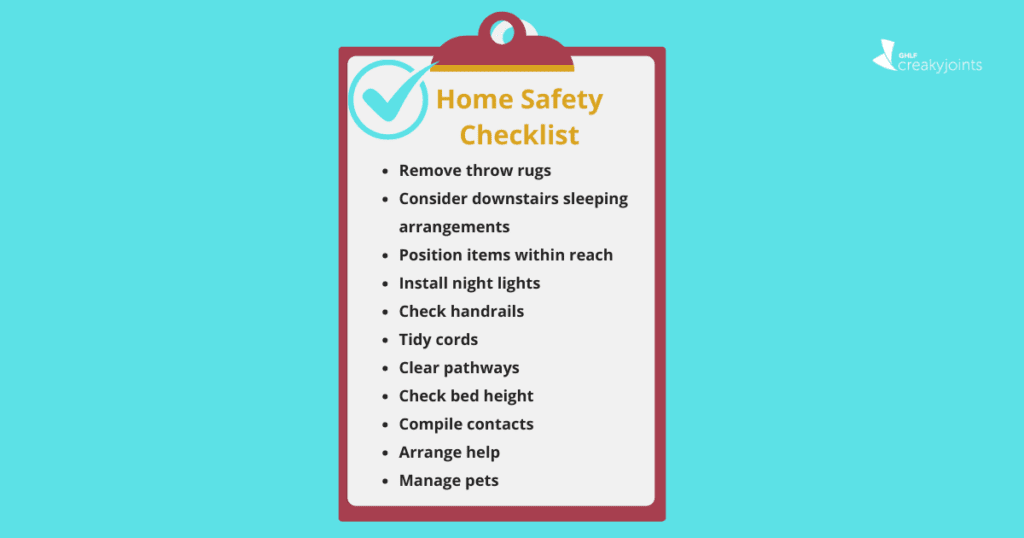

Recovering from artificial knee replacement surgery begins before you even leave for the hospital. It’s about creating a safe, convenient space for when you return and working with family and friends who will help you recover to mentally and physically prepare for the best path to healing,” says James Cook, DVM, PHD, OTSC, William & Kathryn Allen Distinguished Chair in Orthopaedic Surgery at the University of Missouri’s Department of Orthopaedic Surgery. “Taking a team approach to preparing your body, mind, and home for the post-surgical journey will tremendously enhance your recovery.”
Read on for a roadmap to a recovery-friendly home, ensuring everything you need is right where it should be.
Transportation Made Easy
Coming home after your knee OA surgery doesn’t have to be a puzzle. With a little planning, your journey can be smooth and stress-free.
Here’s a step-by-step guide to help you maintain comfort and safety while getting in and out of a car:
- Seat adjustment: Before you approach the car, have the front passenger seat pushed back and reclined to create more room for maneuvering.
- Vehicle choice: Opt for a standard-size vehicle during recovery. Cars that are too high or low can pose challenges.
- Parking setup: Ensure the driver chooses a flat surface for parking to facilitate easier entry and exit.
- Approach with care: Use your walker or crutches to approach the vehicle safely.
- Backing In: Turn and back up to the seat, rather than stepping in, to reduce strain.
- Seat sliding: A plastic bag on the seat can help you slide into position without twisting.
- Steady support: Use the door frame and car seat for support as you lower yourself down.
- Leg movement: Swing your legs into the car one at a time, keeping toes pointed upwards.
- Comfort first: Once inside, adjust the seat for maximum comfort before starting your journey.
- The exit strategy: To exit, simply reverse these steps, being mindful of your movements.
Helpful hint: For longer trips, plan to take breaks every 30 to 45 minutes to walk around and prevent stiffness. And before you consider driving again, consult with your doctor to ensure it’s safe.
Navigating Your Home with Assistive Devices
After knee surgery, your mobility will be limited. The right assistive devices can make all the difference.
- Start with a walker: Gain independence with a walker before transitioning to a cane.
- Enhance your bathroom: A toilet seat riser and a shower chair can make your daily routine safer and easier.
Consider these tools your allies in regaining mobility and confidence.
Home Safety Checklist
Before surgery, take time to create a safe space that promotes healing and prevents accidents.
These precautions can help prevent complications and support your journey to regaining mobility and independence after your knee OA surgery.
- Throw rugs: Remove them to prevent slips or trips with your walker or cane.
- Night lights: Install them along the pathway to your bathroom to avoid fumbling in the dark.
- Stairway solutions: If your bedroom is upstairs, consider setting up a temporary sleeping area on the ground floor.
- Secure handrails: Check that all handrails on stairways are firmly attached for reliable support.
- Cord management: Tidy away cords from electronics to eliminate hazards.
- Furniture arrangement: Organize your furniture to create clear and wide pathways for easy navigation.
- Item accessibility: Position commonly used items within reach to avoid unnecessary bending or stretching.
- Communication access: Keep a cordless or mobile phone within arm’s reach at all times.
- Bed height: Ensure your bed is the right height for easy access—aim for mid- to low-thigh level when seated.
- Recovery chair: Choose a stable chair with a high back and firm seat, one without wheels, to be your primary seat post-surgery.
- Support network: Compile a list of contacts — friends or family — who can assist with errands or transportation.
- Chore assistance: Arrange for help with regular household tasks and yard work during your recovery.
- Pet care: Plan for the safe management of pets to avoid accidental trips or falls.
By ticking these boxes, you’re setting up for a smoother recovery.
A Call for Caregivers
Post-surgery life will be different, at least for a while. Asking for support from loved ones to lend a hand can help make it easier.
- Transport support: Arrange rides to follow-up appointments.
- Reminders: Ask for guidance to provide reminders on when to take your medications, keep up with exercises from physical therapy.
- Daily living activities: Assist with basic tasks like dressing and bathing.
- Household management: Keep the living space clean and hazard-free.
- Errand assistance: Plan for help with the shopping and other errands.
- Meal prep: Prepare easy-to-heat meals and ensure the kitchen is set up for low-effort use.
- Companionship: A friendly face and encouraging words can be as healing as any medicine.
With these measures in place, you can focus on healing.
When to Call Your Surgeon
Know the signs that indicate it’s time to contact your surgeon, including:
- A fever over 101.3 F
- Wound bleeding or pus
- Wound draining more than five days after your surgery
- Increased pain or difficulty moving joint
- New pain in your calf or thigh muscle
- Difficulty emptying bladder or having bowel movements for more than two days
- Inability to participate in physical therapy
Be a More Proactive Patient with PatientSpot
PatientSpot (formerly ArthritisPower) is a patient-led, patient-centered research registry for people living with chronic conditions. You can participate in voluntary research studies about your health conditions and use the app to track your symptoms, disease activity, and medications — and share with your doctor. Learn more and sign up here.
This article was made possible with support from the Missouri Orthopaedic Institute.





